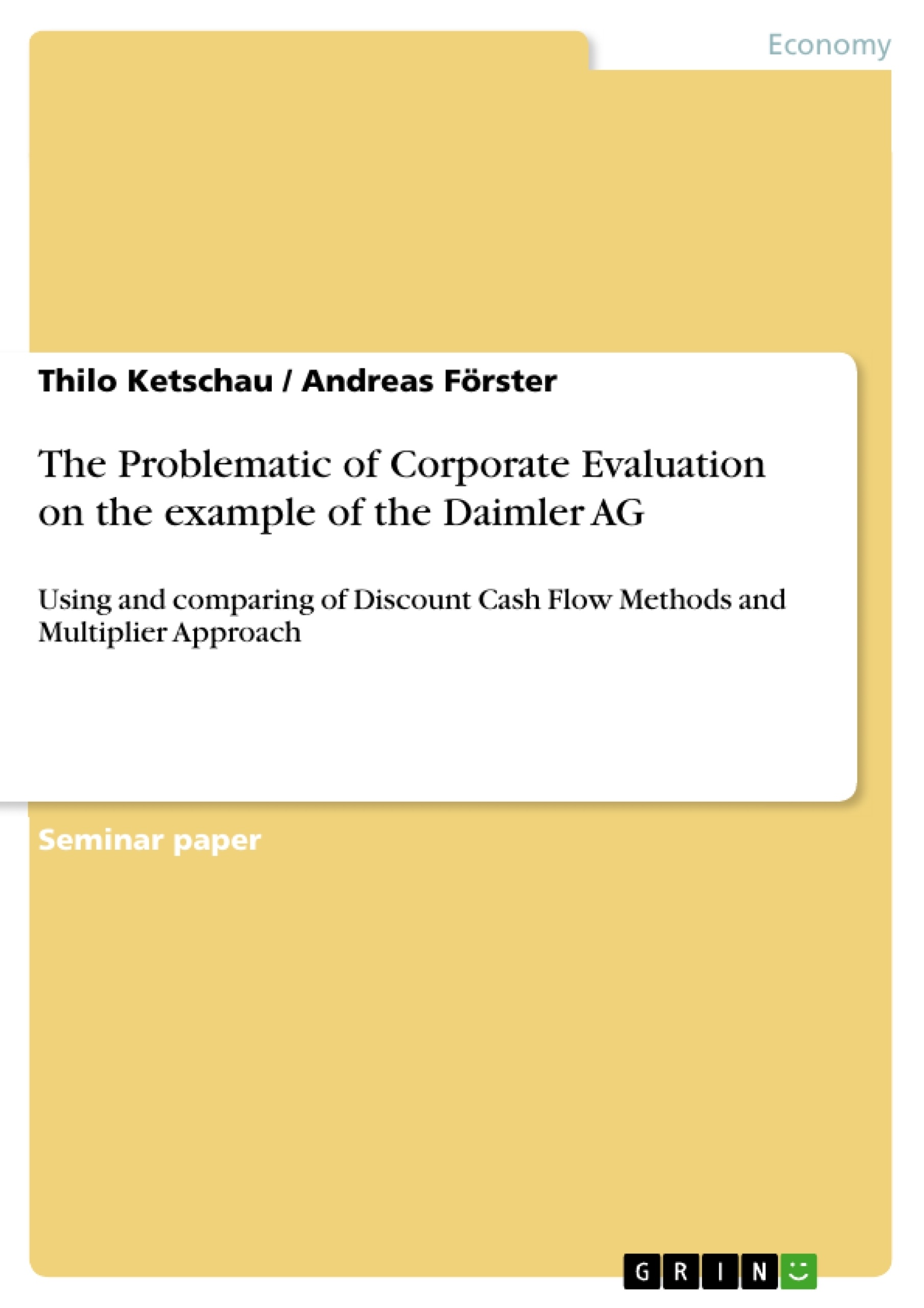The methods to evaluate the value of a company are numerous and diverse. In this assignment the theoretical framework of company evaluation is described and the popular approaches depending on discounted cash flows or multipliers are explained and used on the example of the Daimler AG. The different value results are discussed in the concluding part.
Inhaltsverzeichnis (Table of Contents)
- Executive Summary
- Table of Contents
- List of Abbreviations
- List of Figures
- List of Tables
- 1 Introduction
- 1.1 Problem Definition
- 1.2 Objectives
- 1.3 Methodology
- 2 Theoretical basis of a Corporate Evaluation
- 2.1 Evaluation Reasons
- 2.2 Purpose and Function
- 2.3 Investment Theoretical Approach
- 2.4 Methods
- 2.5 Empirical references and other frameworks
- 3 Company Profile of the Daimler AG
- 4 Discounted Cash Flow Methods on use on the Daimler AG
- 4.1 Entity Approach
- 4.1.1 Weighted Average Cost of Capital
- 4.1.2 Free Cash Flow (FCF)
- 4.1.3 Underlying assumptions
- 4.1.4 Calculation of the FCF
- 4.1.5 Calculation of the equity capital value
- 4.2 Equity Approach
- 4.2.1 Flow to Equity (FtE)
- 4.2.2 Calculation of the equity capital value
- 5 Multiplier Method
- 5.1 Calculation of the multipliers
- 5.2 Calculation of the equity capital value
- 6 Evaluation and Critical Consideration
- 6.1 DCF Method
- 6.2 Multiplier Method
- 7 Conclusion
- Bibliography
- Declaration
- ITM-Checklist 1: 360-degree analysis
Zielsetzung und Themenschwerpunkte (Objectives and Key Themes)
This assignment aims to explore and apply different corporate evaluation methods to assess the value of Daimler AG. The paper delves into the theoretical framework of company evaluation, focusing on discounted cash flow and multiplier approaches. It analyzes and compares the different value results derived from these methods.
- Theoretical framework of company evaluation
- Application of discounted cash flow and multiplier approaches
- Comparison of value results
- Analysis of Daimler AG using chosen methods
- Critical consideration of the evaluation approaches
Zusammenfassung der Kapitel (Chapter Summaries)
The paper begins with an introduction outlining the problem definition, objectives, and methodology. Chapter 2 provides a theoretical foundation for corporate evaluation, discussing evaluation reasons, purpose and function, the investment theoretical approach, and various methods employed. Chapter 3 introduces the company profile of Daimler AG.
Chapter 4 focuses on the application of discounted cash flow methods to Daimler AG. It explores both entity and equity approaches, including detailed calculations of the weighted average cost of capital, free cash flow, and equity capital value. Chapter 5 analyzes the multiplier method, presenting the calculation of multipliers and their application to determine the equity capital value.
Finally, Chapter 6 offers a critical evaluation of the discounted cash flow and multiplier methods, highlighting their strengths and weaknesses.
Schlüsselwörter (Keywords)
Corporate valuation, Daimler AG, Discounted Cash Flow (DCF), Free Cash Flow (FCF), Weighted Average Cost of Capital (WACC), Flow to Equity (FtE), Multiplier Method, Enterprise Value (EV), Equity Capital Value (EC), Financial Management, Investment Theory, Valuation Techniques, Company Analysis.
- Quote paper
- Dipl. Päd. Thilo Ketschau (Author), Andreas Förster (Author), 2013, The Problematic of Corporate Evaluation on the example of the Daimler AG, Munich, GRIN Verlag, https://www.grin.com/document/210903



